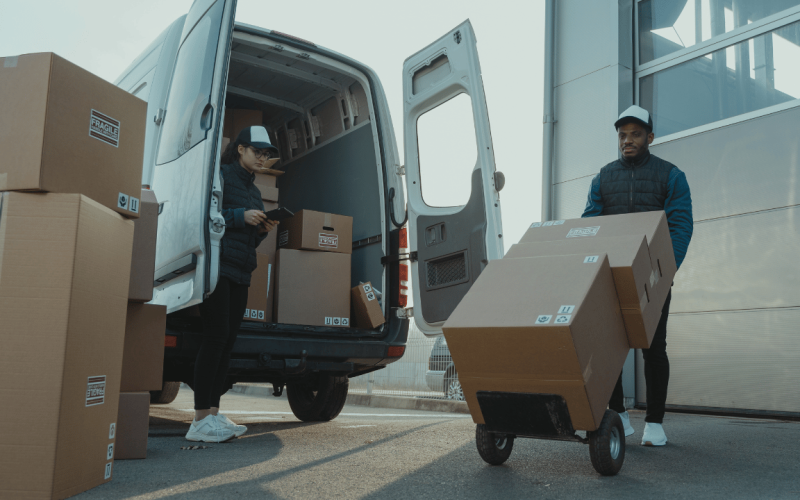Have you considered starting a hotshot trucking company? It can be a lucrative industry if you go in with a solid plan.
As an owner-operator, you can be your boss and set your hours. If you don’t mind long hours traveling to deliver time-sensitive freight, hotshot trucking may be for you.
All you need to get started is a pickup truck, trailer, and the determination to make it work.
With low startup costs but the potential for high profits, hotshot trucking is an attractive business for entrepreneurial individuals looking to work for themselves.
If you have a sense of adventure and want the freedom of the open road, starting a hotshot trucking company may be your ticket to success.
Read Also: Uber Driver Review: Is Uber A Worthy Side Hustle?
Pros of Starting a Hotshot Trucking Company
There are several good reasons to start a hotshot trucking business:
1. Lower Barrier to Entry
Hotshot trucking offers a more accessible entry point into the trucking industry than traditional semi-truck operations.
It allows drivers to start their careers without immediately acquiring a commercial driver’s license (CDL) and investing in a semi-truck.
2. Lower Operational Costs
A hotshot truck typically involves lower operational costs than semi-trucks. Monthly truck payments and fuel expenses are generally more affordable for pickups, leading to potential cost savings for drivers.
3. Flexibility and Versatility
Hotshot trucking provides flexibility regarding the types of loads and routes that can be undertaken.
Drivers have the opportunity to haul smaller loads, which are often time-sensitive and may require faster delivery to a single destination.
4. Potential for Higher Earnings
Due to lower operational costs and the ability to complete more frequent trips, hotshot truckers can earn comparable or even higher incomes than drivers operating Class 8 semi-trucks.
Cons of Starting a HotShot Trucking Company
Before venturing into the hotshot trucking business, there are some downsides to consider:
1. Intense Competition
Hotshot trucking is a popular choice among drivers, leading to intense competition in the industry.
The market can be saturated with other drivers vying for the same loads and customers, requiring owner-operators to differentiate themselves and provide exceptional service to stay competitive.
3. Higher Insurance Rates
Hotshot trucking may entail higher insurance rates than traditional semi-truck operations.
Insurance providers often consider hotshot trucking a higher-risk venture, leading to increased premiums.
How to Start a Hotshot Trucking Company
Hotshot trucking is transporting smaller, less-than-truckload (LTL) loads that are often time-sensitive and delivered to a single destination.
An example of hotshot trucking would be when a construction company needs to transport a specific piece of equipment between job sites and hires a driver to deliver the load quickly.
Unlike being on standby, hotshot drivers typically find freight opportunities through load boards, which allow them to take on jobs as independent owner-operators and earn additional income.
If you’re interested in starting a hotshot trucking business, it’s essential to understand the requirements and steps involved.
1. Create a Hot-Shot Trucking Business Plan
You’ll need a solid business plan to get your hot-shot trucking company up and running.
Here are the key things to include:
Research Your Target Market and Potential Customers
Who will you be hauling freight for? Focus on a niche to start, like heavy machinery or agriculture equipment. Study their shipping needs and patterns.
Outline Your Operational Details
How many trucks and drivers will you start with? What are your equipment costs?
Remember insurance, licensing, and compliance with regulations. Map your routes and shipping hubs.
Create Financial Projections
Figure out your startup costs, operating expenses, and potential revenue and profits. Aim for breaking even within 6-12 months.
Track key metrics like cost per mile and revenue per truck to measure success.
Define Your Competitive Advantage
What makes you different? Maybe you offer extra services like load securing or have more experience shipping oversized loads. Highlight what sets you apart.
Describe Your Marketing Plan
How will you find new customers and keep trucks filled? A professional website, social media, industry events, and referral programs can all help get the word out about your new company.
2. Selecting a Niche
If you’re new to hotshot freight hauling, it’s beneficial to specialize in specific types of cargo based on the equipment you have or can access.
Choosing a specific niche makes it easier for customers to refer you for similar work.
It’s essential to choose an industry you are passionate about from the beginning and remember that you can always make adjustments along the way.
Starting a hotshot business allows you the flexibility to specialize in lightweight cargo or even invest in small refrigeration trucks or trailers for transporting medical or perishable goods.
3. Get a Truck and Trailer
You cannot start a hotshot trucking company without having a truck; the truck would be based on your area of specialty.
Different trucks and trailers are designed to handle different loads.
Hotshot trucks are typically medium-sized, larger than pickup trucks, and fall into different weight classes:
- Class 3 medium-duty trucks have a weight limit of 10,001-14,000 pounds but can also handle lighter hotshot loads.
- Class 4 medium-duty trucks have a weight limit of 14,001-16,000 pounds.
- Class 5 medium-duty trucks have a weight limit of 16,001-19,500 pounds. Many of the lightest commercial trucks fall into this category.
Trailers can also be used for specific jobs:
- Bumper pull trailers have lower hauling capacities, typically under 10,000 pounds.
- Gooseneck trailers have a tighter turning radius than bumper pull trailers and can handle larger and heavier loads.
- Tilt deck trailers tilt at an angle to facilitate more effortless loading of heavy cargo.
- Lowboy trailers have a low center of gravity, making them ideal for the heaviest loads.
- Dovetail trailers are suitable for hauling cars or equipment with wheels.
4. Purchase other Equipment
Aside truck and a trailer, acquiring the necessary equipment is essential for hotshot trucking.
It’s vital to consider the types of loads you will be hauling and any regulatory guidelines that apply to your operations before buying your equipment
Here are the equipment items typically needed:
Straps, Chains, and Binders
These are essential for securing and tying down the cargo on the trailer. It is recommended to have around 20 straps with ratchets, four 20′-long 3/8″ chains, four binders, and a winch bar for additional cargo security.
Tarps
Two 6′ drop tarps help protect the cargo from the elements, ensuring it stays dry during transportation.
Tarping requires some practice but is a crucial skill for maintaining freight quality.
Safety Equipment
You may need additional safety equipment such as lights, flags, safety triangles, or fire extinguishers.
Ensure compliance with relevant regulations for your specific operations.
Read Also: Start a Mobile Detailing Business to Make More Money
5. Get Licensing and Permits Needed for a Hotshot Trucking Business
You must obtain the proper licenses and permits to operate a hotshot trucking company.
These vary by state, so check with your local transportation department for specifics.
Federal Permits
- Operating Authority Permit from the Federal Motor Carrier Safety Administration (FMCSA). This establishes your company as an authorized for-hire carrier.
State Requirements
- Business licenses or registrations are required in your state. These typically need to be renewed annually.
- Vehicle registrations for each truck in your fleet. These also require annual renewal.
- Driver’s licenses for all company drivers. Hot shot drivers need a regular Class A or B CDL to haul non-hazardous cargo.
- Liability insurance to operate as a for-hire carrier. Most states require $1 million in coverage.
- IFTA fuel tax permits if traveling outside your state. These allow you to report and pay fuel taxes quarterly rather than purchasing trip permits for each state.
- Unified Carrier Registration (UCR) which funds state enforcement of federal safety regulations. Fees are based on your fleet size.
6. Find Profitable Loads and Building Your Client Base
Finding steady, profitable freight is key to building a successful hot-shot trucking company.
As an owner-operator, you must market your services to shippers and brokers to get your business up and running.
Build a Website
Create an essential website to help market your hotshot trucking services. Include details about your truck, experience, insurance, and operating authority.
Optimize your site for search engines by including relevant keywords like “hot shot trucking,” “same day delivery,” and “expedited freight.”
Search Load Boards
Websites like Truckloads, DAT Solutions, and 123Loadboard are major freight marketplaces where shippers post loads needing to be moved.
Regularly check for expedited loads in your operating region that match your truck’s capacity. Be ready to book the loads quickly before other hotshot carriers.
Build Strong Relationships
Go the extra mile to provide great service to your new clients. Be on time for pickups and deliveries, communicate well, and get their cargo to its destination as promised.
Ask for reviews and testimonials to build trust and social proof for your business. Satisfied clients will continue using your services and also refer you to others.
With time and persistence, you can develop a robust and loyal client base and consistent source of profitable freight to keep your hot shot truck moving.
Staying highly responsive, accountable, and dedicated to your customers’ needs will set you up for success.
Conclusion
Starting your hotshot trucking company can be highly profitable if you work to develop a solid business plan, find reliable customers and drivers, and provide great service.
Though it won’t be easy, if you go into this with realistic expectations about the challenges involved and optimism and determination, you can build a successful hotshot trucking company.






